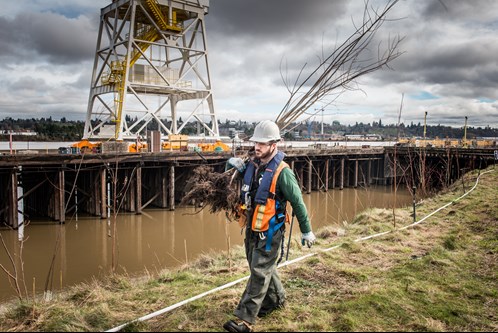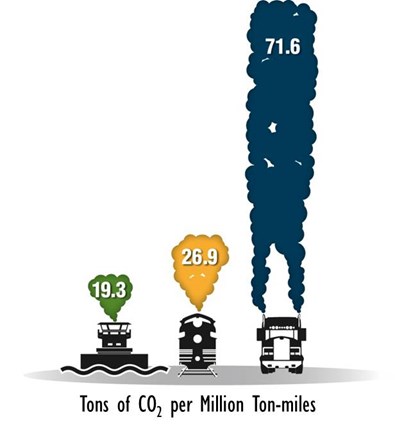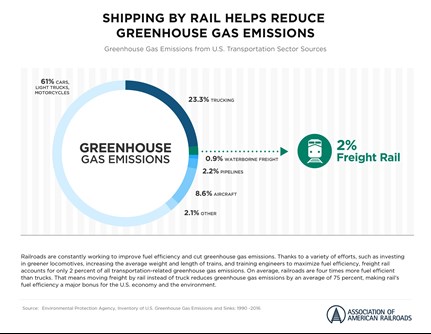
Greenbrier is proud to produce the most environmentally friendly modes of freight transportation. Our products in both the rail and barge markets allow the movement of freight at scale while simultaneously increasing efficiency.
Our customers include railroads, leasing companies, financial institutions, shippers, carriers and transportation companies. Railcars and barges allow these customers to move freight in ways that are safer, more environmentally friendly and cost efficient. In fact, according to the Environmental Protection Agency, freight railroads only account for 0.6% of total U.S. greenhouse gas emissions and only 2% of transportation-related sources. Similarly, waterborne freight only makes up 1.1% of transportation emissions[1].
Rail and barges are far more efficient freight transportation methods than truck. Rail shipments can move one ton of cargo 477 miles on a single gallon of fuel whereas trucks move that same ton of cargo only 145 miles on a single gallon. Barges take fuel savings to the next level, moving one ton of cargo a whopping 647 miles per gallon[2].

Greenbrier Gunderson employees restore waterfront along Willamette River in Portland, Oregon
This clear advantage in fuel efficiency results in decreased greenhouse gas emissions for the environment and economic incentives for our customers. If 10% of the freight currently moved by large truck switched to rail, fuel savings would approach 1.5 billion gallons per year, the equivalent of saving roughly $4.3 billion or planting 400 million trees. There would also be a 75% reduction in greenhouse gases[3]. At Greenbrier, we are committed to using natural resources and energy efficiently.
Another significant benefit of freight rail transportation is reduced traffic congestion across roads. Traffic congestion costs in the U.S. are estimated to exceed $27 billion each year, a number that is expected to continue rising in the future. Rail freight transportation significantly decreases the amount of congestion present on roads. Again, if 10% of freight moved by truck was shifted to rail, the result would be equivalent to 1.8 million automobiles being taken off the road[4].

Source: American Commercial Barge Line
Greenbrier participates in a range of public service initiatives convened by our two main industry associations – the Railway Supply Institute (RSI) and the AAR – to promote rail freight as the preferred mode of freight transportation. Our activities include funding and participation in programs like “Freight Rail Works”. This is an advertising and public relations effort targeted at both shippers and the public to provide education on the efficacy of rail as a freight transport mode.
We are proud that our operations promote the movement of freight in an environmentally conscious way. According to the AAR, freight volume has increased by 104% from 1980−2017, while using significantly less fuel. Railroads and railcar producers have continuously worked together to improve designs, implement more efficient technologies and overall mandate higher quality operating processes.
At Greenbrier, we are committed to addressing environmental risks through sustainable design, green technology use and the continued promotion of shipping by rail.

[1] “Freight Railroads Embrace Sustainability & Environmental Preservation.” Www.AAR.org, Association of American Railroads, 2019, www.aar.org/wp-content/uploads/2019/02/AAR-Sustainability-Fact-Sheet-2019.pdf.
[2] “Barge Transport Wins on Fuel Efficiency.” The Maritime Executive, 29 Mar. 2017, www.maritime-
executive.com/article/barge-transport-wins-on-fuel-efficiency.
[3] “Barge Transport Wins on Fuel Efficiency.” The Maritime Executive, 29 Mar. 2017, www.maritime-
executive.com/article/barge-transport-wins-on-fuel-efficiency.
[4] “Freight Railroads Embrace Sustainability & Environmental Preservation.” Www.AAR.org, Association of
American Railroads, 2019, www.aar.org/wp-content/uploads/2019/02/AAR-Sustainability-Fact-Sheet-2019.pdf.

